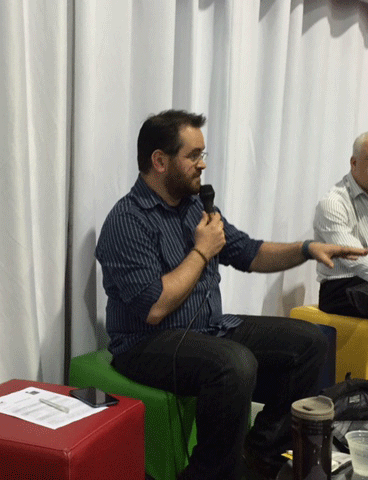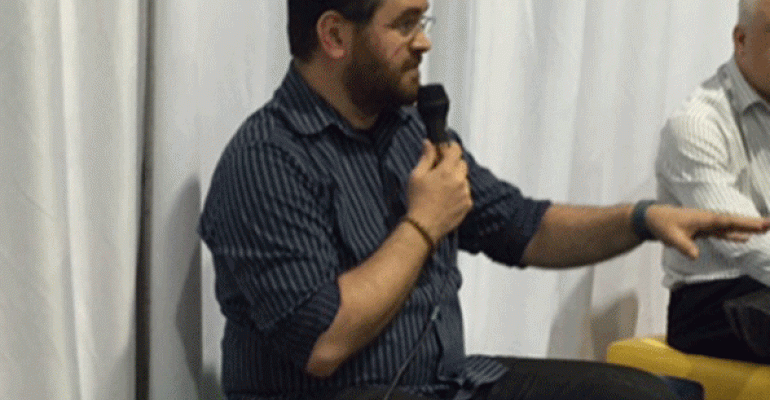
Meeting and event technology consultant Brandt Krueger was a fountain of information on all things audiovisual during several sessions he led at IMEX America in Las Vegas. Here are just a few of my takeaways from the bits and pieces I was able to make it to.
1. Know your inputs and your outputs. Every soundboard and video switcher has a fixed number of places you can plug in mics, cameras, etc., and a fixed number of places you can export the audio or visual to speakers, screens, etc. I will not attempt to explain inputs and outputs further, but it is key that planners know how many they’ll need ahead of time so the AV provider can plan to bring the appropriate mixers. If they end up having to use a larger mixer than originally anticipated, it likely will cost you more.
And be sure to count every single input and output, including to things like translation booths and webcasts. And remember that any video output that is going to be different on different screens—instead of all screens showing the exact same thing all the time—will count as more than one output. Brandt also said to be sure to ask the AV company what video inputs and output connectors they prefer—HDMI, VGA, etc. (I just Googled it, and there are a lot of them! But these two are the most popular these days, according to Brandt.) If all your laptops will have HDMI connectors and the AV company has VGA, they’ll need a converter, he said.
2. Know the width of the stage and the depth of the room. Very wide stages end up having “cones of silence” in front of the center where the side speakers don’t reach, so you’ll need “center fill” speakers. If the room is very deep, you’ll likely need “delays” to move the sound all the way to the back. Line arrays, which are often flown from a truss or the ceiling, are a more expensive alternative, but may be worth it because they offer really good sound.
3. You can try to negotiate patch fees and rigging points up front. Patch fees—which some venues charge to patch into their in-house system—may be negotiable, but only before the contract is signed, he said. Ask the venue if it has rigging points—those points on the ceiling or an I-beam that have hooks to hang trusses and rigging from—and if so, how many, and how much they charge to use them. While the venue may not be able to negotiate rigging point usage fees if the rigging points are owned by the in-house AV company, it doesn’t hurt to ask if they can negotiate with the company on your behalf.
4. You can get around paying to have a backup projector by asking to use “running spares.” Instead of using one high-lumen (expensive) projector and paying for them to have a spare in case it goes down, ask to use two lower lumen projectors stacked on top of each other. While they do have to be aligned perfectly and the image won’t be quite as bright, if one goes down, you have a built-in backup already on hand.
5. Don’t expect to find any consistency in pricing. Whether it’s rigging points or Wi-Fi, you’re going to find pricing to vary wildly from venue to venue and destination to destination, he said. “All you can do is try to track it.” For Wi-Fi, you can ask the venue for a report on how much bandwidth you used—“you may just hear crickets, but some will provide this information,” he said. You also can ask your meeting app provider about how much data their app will use to get some idea of how much bandwidth you’ll need. And try to find out how many devices each of your attendees and exhibitors are likely to be using, because that also can have a pretty dramatic effect on bandwidth.
Good resource: While I didn’t hear him mention it during his sessions, I found this great glossary of live event tech terminology on his site that will help make anyone—even an event AV neophyte like me—feel more confident when talking event tech.
Great quote: I’ll leave you with my favorite Brandt quote: In response to a question about how many technicians to have in the room (of course, “It depends,” but generally speaking, the more important the session is to the event, the more techs you want to have available), Brandt said, “It’s very common to have techs floating from session room to session room, hanging out in the hallways like Batman waiting for sounds of panic.” I have wanted to hand out capes to the guys I see doing just that ever since!
| Suggested Categories | More from MeetingsNet |
|
|
|
 |
|





